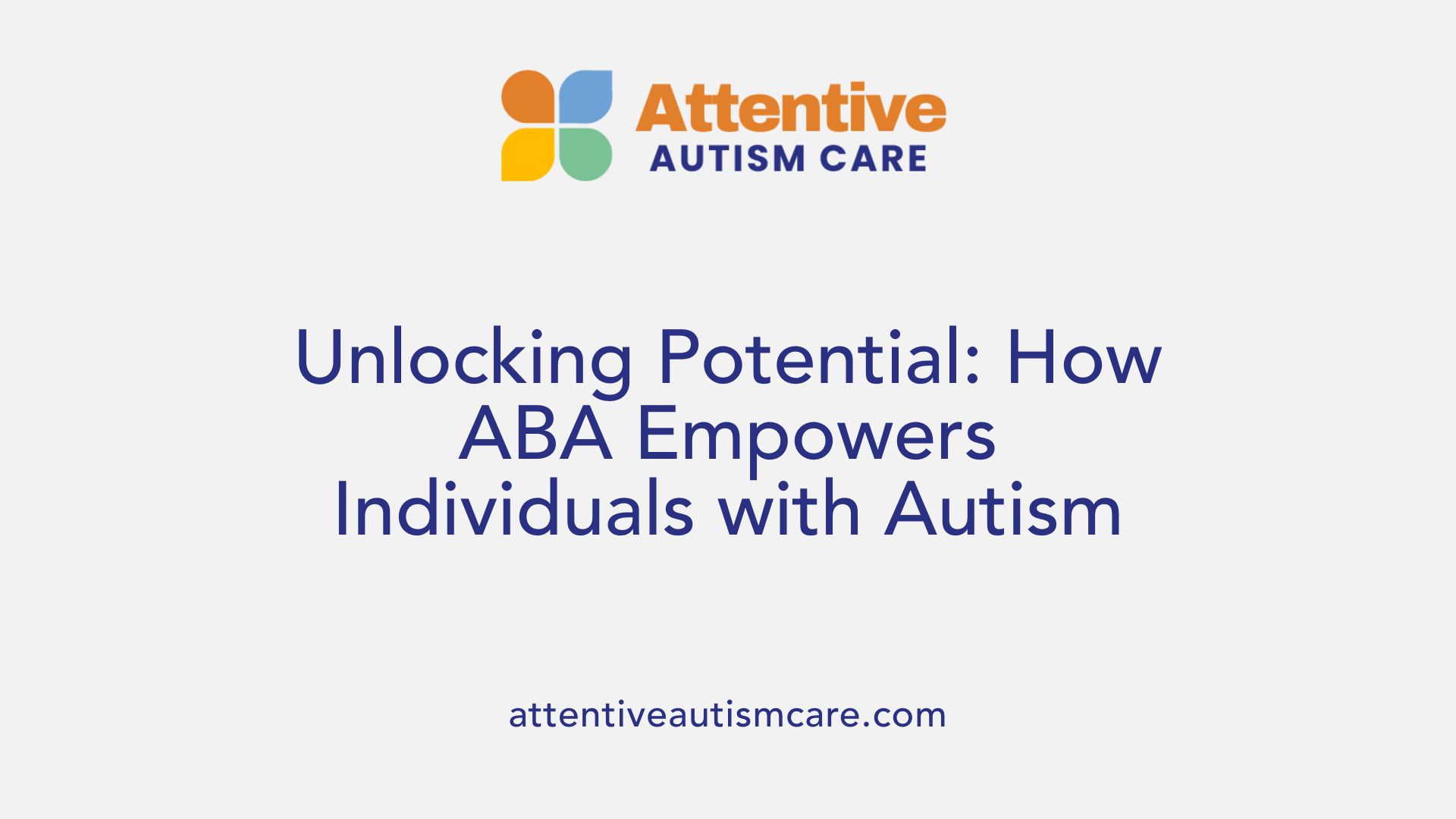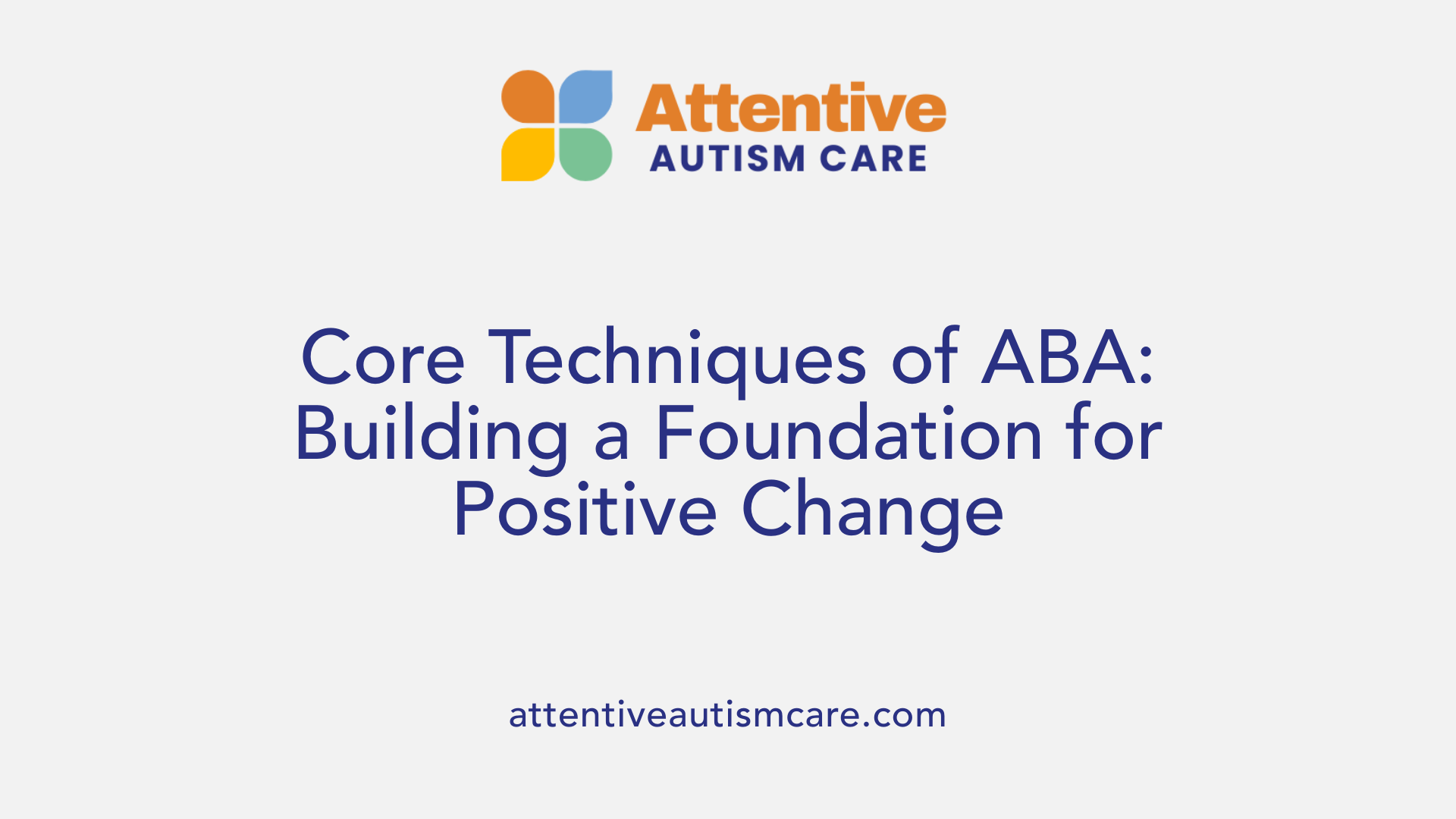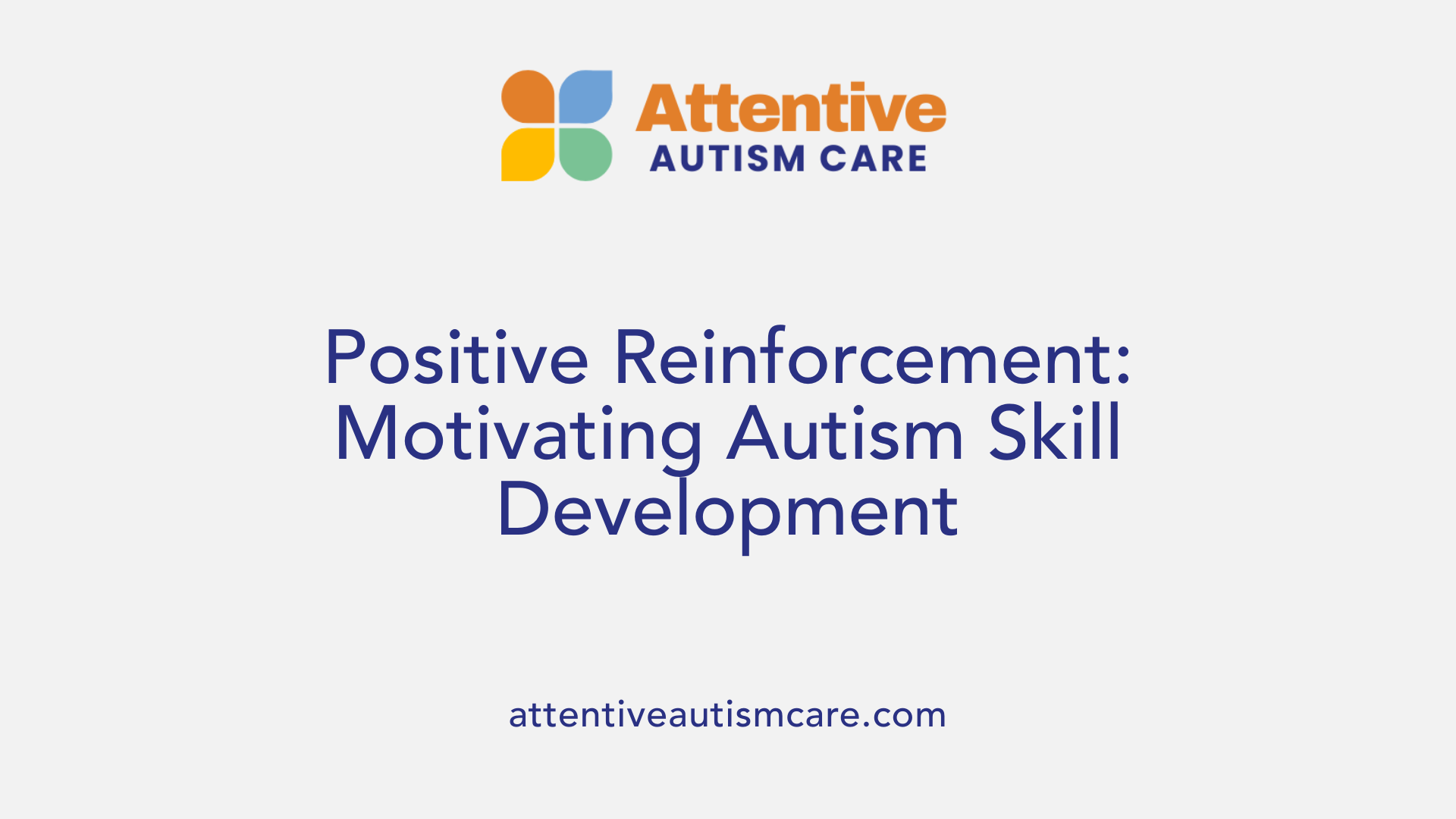How to Use Positive Reinforcement to Encourage Autism Skills
Empowering Autism Development Through Positive Reinforcement

Understanding Positive Reinforcement in Autism Therapy
Positive reinforcement plays a fundamental role in encouraging skill development and positive behaviors in individuals with autism. This article explores the application of positive reinforcement within Applied Behavior Analysis (ABA) therapy and related approaches, highlighting how it facilitates meaningful behavioral changes and supports long-term growth.
What is Applied Behavior Analysis (ABA) Therapy?

What is Applied Behavior Analysis (ABA) therapy?
Applied Behavior Analysis (ABA) therapy is a scientifically-based approach designed to teach and improve socially important skills for individuals with autism spectrum disorder and other developmental challenges. Through a detailed examination of how behavior relates to the environment, ABA aims to increase positive behaviors like communication, social abilities, and self-care, while reducing behaviors that may interfere with learning and functioning.
Scientific basis and goals
ABA is grounded in the principles of learning theory and focuses on meaningful behavioral changes that improve an individual’s quality of life. It emphasizes careful observation and measurement of behaviors, using data collection to track progress and inform adjustments to treatment plans. The primary goals include enhancing language, social interactions, independence, and daily living skills tailored to each individual’s needs.
Techniques used in ABA
Several techniques form the core of ABA therapy, including positive reinforcement which rewards successful behavior to encourage repetition. Prompting, such as demonstrations or physical guidance, assists individuals in completing tasks and is gradually faded to promote independence. Other strategies include breaking down complex actions into small steps (task analysis), behavior chaining, modeling, and using visual supports like charts and video modeling to aid learning. Specialists also employ behavior contracts to set clear expectations, extinction procedures to reduce undesired behaviors, redirection to shift focus, and script fading for social situations.
Individualized treatment and data collection
ABA therapy is highly individualized, with goals and teaching plans developed based on the unique strengths and challenges of each person. Interventions often occur in one-on-one settings where therapists tailor instruction and reinforcement to suit the learner. Continuous data collection helps track behavior changes, measure effectiveness, and guide modifications to ensure steady progress toward meaningful skill acquisition and independence.
The Benefits of ABA Therapy for Individuals with Autism

How does ABA therapy benefit individuals with autism?
ABA therapy is a scientifically supported approach that offers numerous benefits for individuals with autism. By breaking tasks into manageable steps and using positive reinforcement, ABA helps build essential skills in communication, social interactions, and daily living. This approach not only encourages desirable behaviors but also reduces challenging or disruptive behaviors by identifying and addressing their triggers.
Skill development through ABA
ABA therapy emphasizes teaching language, social, and other functional skills through short, simple tasks. Techniques like visual modeling, prompting, and behavior chaining allow children to learn complex skills in a structured way. Early interventions, such as the Early Start Denver Model, incorporate play and family involvement to foster growth in young children’s cognitive, emotional, and language abilities.
Communication and social skill improvements
Using strategies like Pivotal Response Treatment (PRT), ABA promotes critical behaviors such as motivation and initiating communication. This play-based method enhances not only social interactions but also academic skills. Consistency in using these techniques at the clinic and home ensures broader improvements and encourages children to engage more actively with others.
Behavior reduction using ABA
ABA utilizes methods such as extinction, redirection, and behavior contracts to reduce undesirable behaviors. Positive reinforcement shifts the focus to rewarding good behaviors rather than punishing negative ones, creating a calm and supportive environment conducive to learning. By identifying triggers for negative behaviors, ABA also helps eliminate or minimize these influences.
Promotion of independence and adaptability
A significant goal of ABA is fostering independence. By systematically fading prompts and assistance, individuals gradually perform tasks on their own. This stepwise learning builds confidence and supports adaptability to different environments like school, home, and social settings. Continued caregiver training ensures that therapy principles are reinforced beyond clinical sessions, enabling lasting positive change.
| Benefit Area | ABA Techniques Used | Outcome for Individuals with Autism |
|---|---|---|
| Skill Development | Behavior chaining, visual modeling, prompting | Acquisition of language, social, and daily living skills |
| Communication & Social Skills | Pivotal Response Treatment, play-based therapy | Increased motivation, initiation of communication, improved social engagement |
| Behavior Reduction | Positive reinforcement, extinction, redirection | Decrease in challenging behaviors and improved emotional regulation |
| Independence & Adaptability | Prompt fading, caregiver training | Enhanced self-confidence and ability to navigate varied environments |
Providers and Settings for ABA Therapy Delivery

Who Provides ABA Therapy Services?
ABA therapy is delivered by a variety of trained professionals specializing in applied behavior analysis. This includes Board-Certified Behavior Analysts (BCBAs), licensed psychologists, and therapists with ABA-specific training. Many of these practitioners hold accreditations from reputable organizations like the Behavioral Health Center of Excellence (BHCOE), which assures families of the provider's commitment to maintaining high standards of care.
Types of Providers and Accreditation
Providers may operate independently, within clinics, or as part of larger organizations. Accreditation by bodies such as BHCOE is a helpful indicator of quality and adherence to ethical guidelines. These credentials are important not just for trust but also to ensure that interventions are evidence-based and customized to each child's needs.
Settings for ABA Therapy Sessions
ABA therapy can be provided in numerous settings to best meet a child's needs. Common environments include:
- In-home sessions: Offering therapy in the child's familiar surroundings, enhancing generalization of skills.
- Clinics or centers: Equipped spaces focused on therapy with specialized materials.
- Schools: Supporting skills in the educational context.
- Telehealth: Remote therapy sessions expanding access, especially in underserved areas.
Caregiver Training and Collaboration
A critical component of effective ABA therapy is caregiver involvement. Specialists, such as those at the Child Study Center, train parents and caregivers in ABA techniques. This training supports consistency and continuation of therapeutic strategies beyond professional sessions, making home the primary learning environment. Caregiver collaboration ensures that progress is reinforced and that skill acquisition is meaningful and lasting.
Together, these elements form a comprehensive delivery system that adapts to individual families and children, aiming for the most impactful outcomes in learning and behavior development.
Core Techniques of ABA Therapy and Their Role in Positive Reinforcement

What are the common techniques used in ABA therapy?
ABA therapy utilizes a variety of structured techniques designed to teach and reinforce desirable behaviors in individuals with autism spectrum disorder.
Positive Reinforcement as a Core ABA Technique
Positive reinforcement is fundamental to ABA, encouraging the repetition of desired behaviors by rewarding successful task completion. This approach not only promotes skill acquisition but also helps build confidence and reduces anxiety.
Prompting and Fading Methods
Prompting involves providing demonstrations, verbal cues, or physical guidance to assist the learner. Gradually, these prompts are faded to foster independence, enabling the individual to perform tasks without assistance.
Task Analysis, Discrete Trial Training, and Behavior Chaining
Complex tasks are broken into small, manageable steps using task analysis. Discrete trial training applies clear, short tasks with immediate rewards, while behavior chaining teaches each step sequentially, linking actions to complete multi-step skills.
Role of Behavior Contracts and Extinction
Behavior contracts establish formal agreements detailing expectations, rewards, and consequences, reinforcing positive behaviors. Extinction works by withholding reinforcement for unwanted behaviors, though it requires careful use to avoid temporary intensification of such behaviors (extinction burst).
These methods work together, supported by visual modeling and real-life practice, to promote meaningful behavioral change. Training caregivers in these techniques ensures continuity of therapy, which is vital for long-term success.
Using Positive Reinforcement to Encourage Autism Skills

What Are the Principles of Positive Reinforcement?
Positive reinforcement is central to Applied Behavioral Analysis (ABA) therapy, aiming to increase desirable behaviors by rewarding them immediately after they occur. By emphasizing positive actions rather than punishing negative ones, this approach motivates children with autism to repeat those behaviors. It also helps reduce unwanted behaviors by redirecting attention to positive alternatives and removing triggers that provoke negative responses.
What Types of Reinforcers Are Used in Autism Therapy?
Different kinds of reinforcers are employed to motivate children effectively during therapy:
- Social Reinforcers: Verbal praise, physical affection, and focused attention.
- Tangible Reinforcers: Toys, stickers, or other small rewards.
- Food Reinforcers: Healthy snacks or special treats used carefully to support motivation.
- Activity-Based Reinforcers: Extra playtime, screen time, or creative activities.
Using a diverse range of reinforcers helps tailor motivation to each child's preferences, increasing the likelihood of successful learning and behavior change.
How Effective Is Positive Reinforcement in Skill Acquisition and Behavior Improvement?
By consistently rewarding target behaviors, positive reinforcement supports learning new skills such as language, social interaction, and daily routines. It fosters a positive environment where children feel confident to try new tasks. For example, Pivotal Response Treatment (PRT), a play-based approach focusing on communication initiation and motivation, heavily relies on reinforcement to drive broader social and academic improvements.
How Does Positive Reinforcement Lay a Foundation for Long-Term Success and Independence?
Beyond immediate behavior changes, positive reinforcement builds confidence and self-esteem. Children learn to regulate their emotions better, leading to reduced anxiety and increased independence. Continued reinforcement helps solidify skills, ensuring they are maintained over time. When caregivers are trained in these strategies, therapy can extend into the home environment, promoting consistent, lasting development.
| Aspect | Description | Impact on Autism Therapy |
|---|---|---|
| Principle | Reward desired behaviors to promote repetition | Encourages positive behavior patterns |
| Types of Reinforcers | Social, Tangible, Food, and Activity-Based | Caters to individual preferences for effective motivation |
| Skill Acquisition | Immediate and consistent reinforcement supports learning new skills | Enhances social, communication, and adaptive behavior development |
| Long-Term Success & Independence | Builds confidence and reduces anxiety, supporting autonomous functioning | Leads to sustained behavior improvements and greater life quality |
Diverse Reinforcement Strategies: Social, Tangible, Food, and Activity-Based Rewards
What Are Examples of Social Reinforcers?
Social reinforcers in ABA therapy include verbal praise, physical affection, and gaining attention. For instance, a therapist might say "Great job!" or offer a high-five to encourage a child. These reinforcers help make the learning process enjoyable and strengthen social bonds.
What Are Tangible Reinforcers Like Toys and Stickers?
Tangible reinforcers involve giving physical items such as toys, stickers, or activity rewards as a form of motivation. These are particularly effective because they provide a concrete reward that children can see and use, which helps maintain engagement during therapy sessions.
How Should Food Reinforcers Be Used Appropriately?
Food reinforcers, such as healthy snacks or special treats, can motivate children, especially when addressing challenging behaviors or introducing new skills. However, their use should be balanced and moderate. Selecting healthy options and pairing food rewards with social or tangible reinforcers prevents over-reliance and supports long-term healthy habits.
What Activity-Based Rewards Motivate Children?
Activity-based reinforcers include extra playtime, screen time, or creative activities. These rewards link positive behaviors to enjoyable experiences, fostering motivation and promoting engagement in both therapy and daily routines.
Each of these reinforcement types plays an important role in shaping behaviors and encouraging skill development in children with autism spectrum disorder. Using a varied reinforcement approach tailored to the child's preferences ensures more effective and lasting positive outcomes.
Integrating ABA-Based Interventions: Pivotal Response Treatment and Early Start Denver Model
Overview of Pivotal Response Treatment (PRT)
Pivotal Response Treatment is a play-based approach derived from Applied Behavior Analysis (ABA) principles. It emphasizes teaching pivotal behaviors that have widespread impact, such as motivation, self-initiation, and communication skills. By focusing on these central areas, PRT aims to promote broader improvements across social, academic, and communication domains.
Plays a Role in Motivation and Communication
PRT specifically targets helping children with autism increase their motivation to engage and initiate interactions with others. This is done through natural play activities that encourage communication and social participation. The approach rewards attempts at communication and initiative, which helps reinforce these critical skills.
Importance of Consistency at Home and Clinic
A vital component of PRT’s success is consistent implementation across environments. Therapists work closely with families, training caregivers to apply the same techniques at home. This seamless integration ensures that children practice pivotal skills regularly, boosting learning and generalization of behaviors.
Early Start Denver Model and Early Intervention Approaches
The Early Start Denver Model focuses on young children aged one to four, combining ABA strategies with developmental and relationship-based approaches. Trained therapists, together with parents and family members, use play and daily routines to build social, emotional, cognitive, and language skills. Early intervention with this model targets autism symptoms reduction while promoting meaningful developmental progress, making it a highly effective option for toddlers and preschoolers on the spectrum.
Caregiver Training and Collaboration to Support Positive Reinforcement at Home
How Are Caregivers Trained in ABA Principles?
Caregivers receive specialized training from experts, such as those at the Child Study Center, to understand ABA techniques thoroughly. This education helps them learn how to deliver prompts, use positive reinforcement effectively, and implement behavior shaping strategies. Training ensures caregivers can confidently support the child's learning process outside the clinic.
Why Is Therapy Continuation Beyond Clinical Settings Important?
Continuing ABA therapy at home provides consistency crucial for skill development and behavior change. When caregivers apply ABA techniques daily, children benefit from repeated practice and natural reinforcement opportunities. This extended engagement helps solidify new skills and promotes independence in real-life settings.
What Role Does Family Engagement Play in Outcomes?
Active involvement of family members positively impacts the effectiveness of ABA therapy. By participating in sessions and learning to use ABA strategies, families create a supportive environment that reinforces learning and reduces behavioral challenges. Collaborative efforts between therapists and families foster trust and ensure therapy goals align with everyday life.
How Can Skills Be Reinforced in Daily Routines?
Caregivers use varied reinforcement techniques—such as verbal praise, tangible rewards, or preferred activities—integrated seamlessly into daily activities. For example, during mealtime or play, caregivers may reward successful task completion, turning routine moments into learning opportunities. This approach leverages natural settings for effective and enjoyable skill practice.
Harnessing Positive Reinforcement for Lifelong Growth
Positive reinforcement is a powerful tool within ABA therapy and related autism interventions that fosters development of vital skills and positive behaviors. Through evidence-based techniques and collaborative approaches involving professionals and caregivers, individuals with autism can experience meaningful improvements in communication, social engagement, and independence. Consistent application of these strategies lays a strong foundation for continued growth, confidence, and quality of life, empowering individuals on the autism spectrum to reach their fullest potential.
References
- Behavioral Therapy for Autism Spectrum Disorder in Children
- ABA Techniques: Strategies for Behavior Analysts - GSEP Blog
- Positive Reinforcement Autism: Effective Strategies for ...
- ABA Therapy Providers Directory
- Applied Behavior Analysis (ABA) Providers | Columbus OH
- Applied Behavior Analysis (ABA)
- Applied Behavior Analysis (ABA)
- The Top 10 Reasons Children With Autism Deserve ABA



































































































